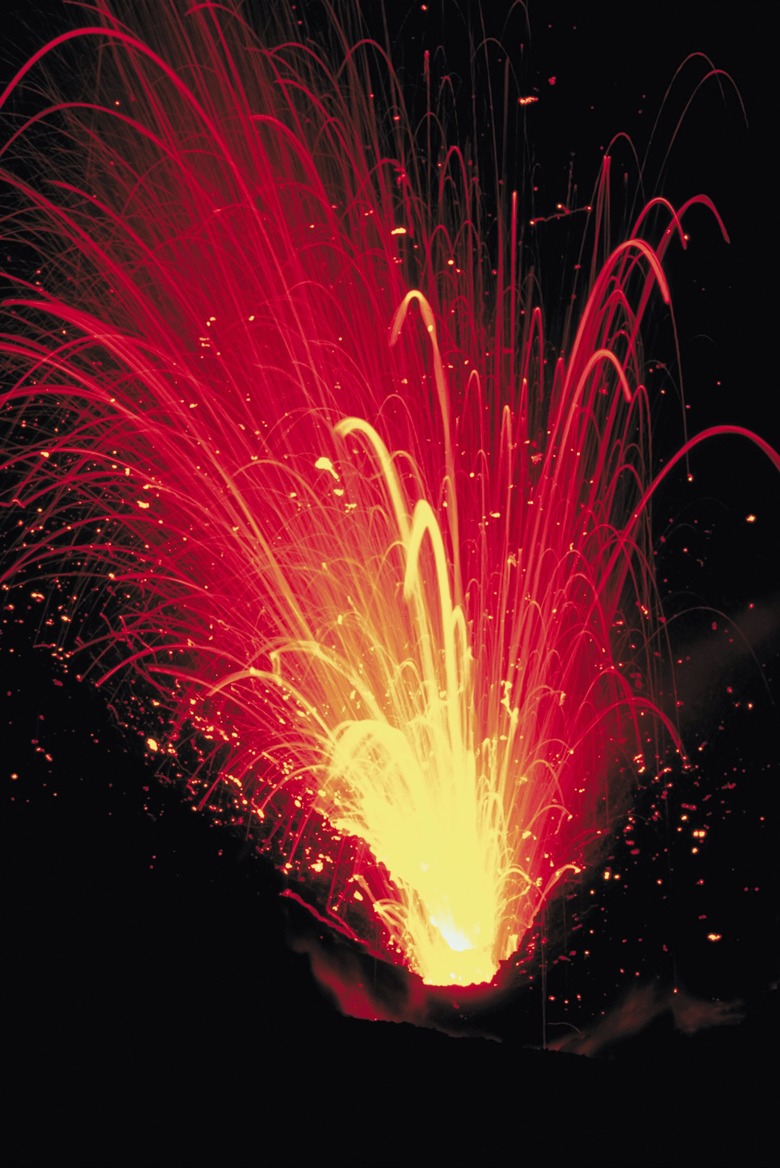What Plates Interacted To Form The Paricutin Volcano?
Paricutin became world famous in 1943 as the volcano born in a Mexican cornfield. Named after one of the villages it obliterated, it is located within a zone of volcanic activity that trends east – west across southern Mexico and is caused by tectonic plates moving against each other. However, the number of tectonic plates involved and how they interact is a geological puzzle as famous as the birth of Paracutin.
Eruptions 1943-1952
Eruptions 1943-1952
Weeks of tremors and rumblings around Paricutin, a village near Urupan, some 320 kilometers south of Mexico City, preceded the first eruption of the volcano on February 20, 1943. That afternoon, the ground in a cornfield swelled two meters before it fractured, hissed and emitted ash and sulfurous vapors. By the evening, flames from the ground rose more than 800 meters into the air. The volcano built a cone of lava and ash that rose to 50 meters in a day, 150 meters after a week, and reached 424 meters by the time eruptions stopped in 1952.
Tectonic Setting
Tectonic Setting
Paricutin stands within the Michoacan-Guanajuato Volcanic Field. This region contains more than 1,400 volcanoes, many of them with short lifetimes like Paricutin. The MGVF zone is part of the Trans-Mexican Volcanic Belt that stretches east-west across Mexico. As the Cocos and Rivera tectonic plates plunge, or subduct, beneath the North America plate, they cause the volcanism. This process also creates a deep trench – the Middle American Subduction Zone – off the western Mexican coast. In most subduction zones, volcanoes and earthquakes occur in an arc parallel to the trench. The Mexican volcanic zone bends at an angle of 15 degrees to the trench and has left geologists wondering why.
North American, Farallon and Pacific Plates
North American, Farallon and Pacific Plates
About 235 million years ago during Late Triassic times, the North American plate – a slab of continental crust upon which Canada, he United States and most of Mexico stand – broke away from the Pangea supercontinent and began to drift westwards. Around 100 million years ago, the North American plate converged with the Farallon plate that was made up of denser oceanic crust and was moving eastwards. The heavier Farallon plate sank, plunged under the North American plate and fragmented. By Oligocene times, about 23 million years ago, most of the Farallon plate was under the North American plate, leaving three remnants: the Juan de Fuca plate to the north and the Cocos and Nazca plates to the south. The Pacific and North American plates moved in to close the gap, creating the San Andreas Fault as they slide past each other.
Cocos Plate Flatenning
Cocos Plate Flatenning
Geologists at the California Institute of Technology believe that as the Cocos plate continued to subduct under the North American plate, it changed its shape from downward dipping to horizontal. A subducting slab has to be buried at least 100 kilometers below the surface to generate the molten magma that creates a volcano. The Cocos plate did not reach this depth until it was almost at the Gulf of Mexico coast. This meant that volcanoes in western Mexico shut off while volcanic activity migrated towards the east. This migration stopped 22 million years ago as the Cocos plate started to dip down again and cause volcanoes to migrate back to the Pacific. As a result, the arc of volcanoes in southern Mexico lies oblique to the Mid America trench.
Rivera Plate
Rivera Plate
About 10 million years ago, the Rivera microplate separated from the northern tip of the Cocos plate. Geologists at the University of Mexico say that at the 20th parallel it dips steeply at more than 50 degrees to the horizontal as it subducts under the North American plate at about three centimeters per year. This is just north of the Michoacan region where Paricutin is located. However, the Cocos plate to the south that underlies Paricutin is flat but subducts under the North American plate at a faster rate of five to six centimeters per year. The complex dynamics between the two plates create volcanoes like Paricutin that have a brief eruptive lifetime.
References
- Smithsonian Institution: Paricutin: The Birth of a Volcano
- San Diego State University: The Eruption of Paricutin (1943-1952)
- California Institute of Technology: The Unusual Case of the Mexican Subduction Zone
- Harvard University: A Geodynamical Perspective on the Subduction of the Cocos and Rivera Plates beneath Mexico and Central America
- Under California: An Ancient Tectonic Plate
- Wenachee Valley College: Geology of the Pacific Northwest
Cite This Article
MLA
Kielmas, Maria. "What Plates Interacted To Form The Paricutin Volcano?" sciencing.com, https://www.sciencing.com/plates-interacted-form-paricutin-volcano-12318182/. 24 April 2017.
APA
Kielmas, Maria. (2017, April 24). What Plates Interacted To Form The Paricutin Volcano?. sciencing.com. Retrieved from https://www.sciencing.com/plates-interacted-form-paricutin-volcano-12318182/
Chicago
Kielmas, Maria. What Plates Interacted To Form The Paricutin Volcano? last modified March 24, 2022. https://www.sciencing.com/plates-interacted-form-paricutin-volcano-12318182/
